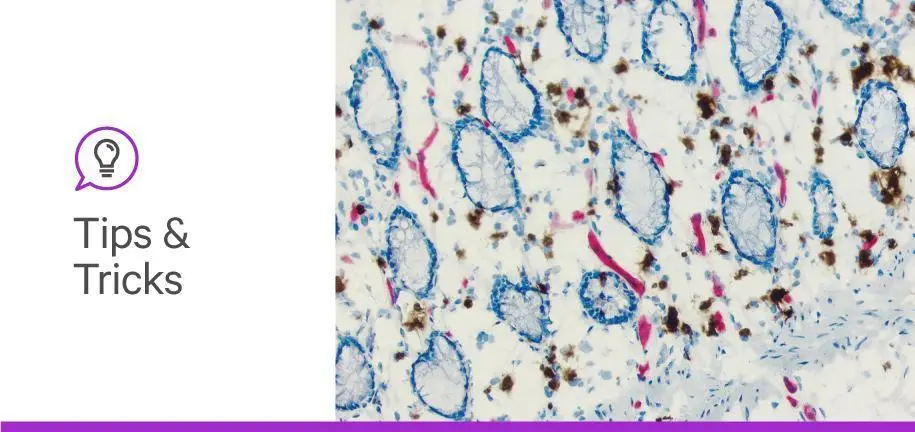
Vector Laboratories is closed for the President’s Day on Monday, February 19th. We will be back in the office on Tuesday, February 20th.
We will respond to emails upon our return. Have a wonderful day.
Menu
Vector Laboratories is closed for the President’s Day on Monday, February 19th. We will be back in the office on Tuesday, February 20th.
We will respond to emails upon our return. Have a wonderful day.

Back in my days as an undergraduate student, I learned to use nail polish to create a hydrophobic barrier on my immunohistochemistry (IHC) and immunofluorescence (IF) slides. The idea was to apply a thin layer of polish around the tissue to reduce the volume of reagents required to complete the experiments. But it just didn’t work that well, at least not for me. I didn’t have the fine motor skills necessary to draw a thin line using a thick brush. I’d smudge polish all over the slide and sometimes on top of the tissue section. Even if I managed to spare the tissue, the polish layer would often get too wide or thick, and I would have to peel it off before applying the coverslip. The entire process was time consuming and frustrating. In my opinion, trying to use nail polish to create a hydrophobic barrier added more trouble than value.
Needless to say, I was grateful when the first PAP pens—pens that deliver a hydrophobic liquid—started to hit the market. After the liquid dries, it forms a thin film that effectively repels fluids, helping reagents stay confined within the delineated area. The quality of the available PAP pens has improved over the years, and now you can’t go wrong. They are straightforward to use, and creating a hydrophobic barrier adds little time to the overall workflow as they can dry in as few as 2 minutes.
PAP pens bring many benefits to IHC and IF workflows. Here are 5 reasons you should add the ImmEdge® Hydrophobic Barrier PAP Pen from Vector Laboratories to your list of essential lab tools as well as a video tutorial on how to use ImmEdge pens.
The purpose of creating hydrophobic barriers is to reduce reagent usage and the cost of IHC and IF experiments. The math is simple: Use half of the volume of reagents to completely cover tissue sections means a 50% savings. But no percentage of savings makes the risk of damaging your tissue and ruining your experiment worth it. PAP pens eliminate the hassle and make the goal of saving reagents and research money possible.
With PAP pens, you can physically isolate different tissue sections on the same slide and incubate them with different reagents. This can be handy in many scenarios, such as when comparing different primary antibodies against the same epitope. During the visualization process, you don’t need to switch between several slides and can simply slide across 2–6 tissue sections. As a result, imaging the sections and comparing the results from each antibody is easier and quicker. The same applies to titration experiments. Specimen visualization and image acquisition will flow much faster when you don’t need to keep switching between multiple slides.
Unlike nail polish, most PAP pens are resistant to alcohol and acetone. Therefore, you can use PAP pens to create hydrophobic barriers at different steps of your workflow knowing you’ll get consistent results. Most PAP pens are also insensitive to detergents (i.e., Tween® 20, Triton X-100) and compatible with enzymes and fluorescence-based detection systems. In addition, hydrophobic barriers won’t interfere with fluorophores and antibodies. Removing the hydrophobic barrier before applying the coverslip is unnecessary. Still, if you need to clean the PAP pen film for any reason, you can use any clearing reagent, such as xylene. Be sure to check the manufacturer’s info sheet to confirm the compatibility of a specific PAP pen.
The ability to endure high temperatures makes PAP pens applicable to other techniques, such as in-situ hybridization. Adding hydrophobic barriers to in-situ hybridization brings the same cost-reduction benefits as in IHC and IF experiments. However, the selected barrier method needs to offer stability at the hybridization temperature indicated in your protocol. Heat-resistant PAP pens also give you the flexibility of applying the hydrophobic barriers before performing heat-induced epitope retrieval.
In addition to all the benefits above, ImmEdge Hydrophobic Barrier PAP Pens are also an environmentally friendly option. They deliver high-quality results, but are free of ozone-depleting hydrocarbons. You can rest assured that your choice to save reagents and research funding won’t come at the expense of the environment.
Creating hydrophobic barriers has become much easier since I first started running immunostaining experiments. Using PAP pens effectively reduces reagent usage and experiment costs without impacting your workflow. If you want to learn other strategies to optimize your staining workflow, check out the Staining Sample Preparation Guide and stay tuned for other tips and tricks from the blog.
Not convinced how easy it is to use the ImmEdge PAP Pen? Watch the video below to see how it’s done.





Stay in the Loop. Join Our Online Community
Together we breakthroughTM

©Vector Laboratories, Inc. 2024 All Rights Reserved.